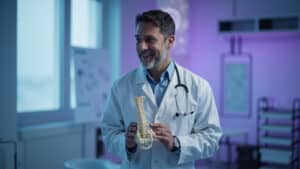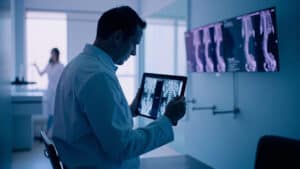Can A Herniated Disc Cause Pain In The Buttocks? A Physician’s Evidence-Based Answer
Written by Dr. Matthias Wiederholz, MD, Quadruple Board-Certified in Physical Medicine & Rehabilitation, Pain Medicine, Sports Medicine, and Regenerative Medicine
Quick Insights
Herniated disc pain in the buttocks occurs when damaged spinal discs compress nerves in the lower back, typically at L4-5 or L5-S1 levels, causing radiating discomfort, numbness, and tingling. About 95% of herniations affect these lower lumbar levels, producing symptoms that extend from the spine through the buttock region and down the leg. Most patients experience improvement through conservative care including physical therapy, targeted injections, or advanced minimally invasive procedures like Discseel®, which repairs damaged discs without surgery while preserving spinal mobility and function. Learn more from MedPix.
Key Takeaways
- Herniated discs most often press on nerves at L4-5 or L5-S1, frequently affecting buttock comfort.
- Typical symptoms can include numbness, burning, or tingling extending from the lower back to the buttocks.
- MRI scans help confirm the link between disc problems and persistent buttock pain.
- Long-lasting pain can reduce mobility, impacting hikers, golfers, and anyone who leads an active life.
Why It Matters
Understanding if a herniated disc causes buttock pain empowers you to seek the right solution before daily activities, sports, or work become harder. Early answers prevent unnecessary worry and support a more active, pain-free lifestyle—without fear of missing out or risking invasive surgery.
As a quadruple board-certified interventional pain and regenerative medicine specialist, I bring extensive experience to answering a common question: Can a herniated disc cause pain in the buttocks?
A herniated disc is one of the most frequent causes of nerve pain in the buttock region, often called sciatica. This condition occurs when the soft inner material of a spinal disc bulges out and compresses nearby nerves. This condition happens when disc material compresses nearby nerves, producing discomfort, numbness, and tingling that can limit sports, fitness, or even simple daily activities in active people across Houston, TX.
For a detailed look at advanced options like Discseel® Procedure, an evidence-based and non-surgical alternative, continue reading. If you’re seeking care from a recognized expert, I invite you to learn more about my approach in my professional biography.
Evidence shows that herniated discs at the lower spine often generate pain radiating from your back into your buttocks and down one or both legs, disrupting comfort and independence for anyone who thrives on movement.
If you’ve felt sidelined by stubborn buttock pain or are frustrated by treatment that hasn’t worked, you’re not alone—let’s explore effective, minimally invasive answers designed to restore your freedom and confidence.
Before diving into the details, understand the relationship between back pain and nerve-related buttock pain—crucial for choosing the right path to recovery.
Can a Herniated Disc Cause Pain in the Buttocks?
A herniated disc can absolutely cause pain in the buttocks. When the soft inner material of a spinal disc pushes out and compresses nearby nerves, it often leads to discomfort that radiates from the lower back into the buttock region. This is especially true at the L4-5 and L5-S1 levels, where most herniations occur. About 95% of herniations affect these lower lumbar levels. If you’re experiencing symptoms at these levels, you may benefit from understanding treatment options specific to L5-S1 pain and its causes, symptoms, and treatment.
Key symptoms of herniated disc pain in the buttocks:
- Sharp, burning, or electric-like pain radiating from the lower back to the buttocks.
- Numbness or tingling in the buttock or leg.
- Pain that worsens with sitting, bending, or lifting.
- Weakness in the leg or foot.
As a quadruple board-certified spine specialist practicing in Houston, I regularly see patients who arrive with persistent buttock pain after trying months or even years of other treatments. In my practice, I frequently encounter individuals who never realized their pain could stem directly from a herniated disc until we perform a thorough evaluation. Clinical evidence shows that the affected nerve root determines the exact pain pattern. For example, compression at the S1 nerve root often causes pain and numbness that wraps around the buttock and extends down the leg.
If buttock pain follows a path down one leg, especially alongside numbness or tingling, it is highly suggestive of nerve involvement from a disc herniation. This makes early expert assessment crucial for accurate treatment. For more about the involved anatomy, see this guide to S1 nerve distribution, anatomy, symptoms, and treatment.
Understanding Herniated Discs and Sciatica
What is a Herniated Disc?
A herniated disc occurs when the nucleus pulposus (the soft center of a spinal disc) pushes through a tear in the annulus fibrosus (tough outer layer). This herniation can pinch or irritate nearby nerves, causing pain, weakness, or tingling. Most herniated discs develop in the lower back—the same area where nerves travel into the buttocks and legs. If you want an in-depth look at disc damage, review disc tear treatment and restoration strategies.
What is Sciatica?
Sciatica refers to pain that follows the path of the sciatic nerve. This large nerve runs from the lower back through the buttocks and down each leg. Most often, sciatica results from a herniated disc pressing on nerves that form the sciatic nerve. The hallmark symptom is a shooting or burning pain that radiates from the buttock down the back of the leg.
Other typical signs include:
- Numbness or tingling in the buttock, thigh, or calf.
- Trouble standing or walking for long periods.
- Pain that worsens with sitting, lifting, or twisting.
As a specialist focused on functional restoration, I know how disruptive these symptoms can be, especially for people in Houston who love to stay active—whether hiking Memorial Park or simply getting through the workday.
Experience-Based Insight: Having performed more than 10,000 minimally invasive spine procedures, I’ve consistently found that patients often wait too long before seeking answers, blaming their buttock pain on simple muscle strain. A clear diagnosis is the first step to regaining full function. Want to learn more about subtle disc injuries? See this comprehensive guide to L5-S1 bulging disc.
How Does a Herniated Disc Cause Pain in the Buttocks?
A herniated disc causes buttock pain by compressing or irritating the nerve roots that provide sensation to the buttocks and legs. The sciatic nerve’s path through the buttocks makes it especially vulnerable to symptoms when a disc herniation occurs at the lower lumbar spinal levels. When disc material bulges out, it may directly press on either the nerve root or even the main sciatic nerve itself.
Professional Assessment Phrase: As a quadruple board-certified regenerative medicine specialist, I’ve observed that precision in identifying the exact location and severity of nerve involvement is crucial. Advanced imaging—especially MRI—helps confirm the presence and level of herniation, guiding treatment decisions. Detailed scans also rule out other causes like muscle spasm or spinal stenosis that can mimic disc pain.
Other medical conditions can cause similar pain, but:
- Disc herniation remains the leading cause of nerve-driven buttock pain.
- The pain pathway matches the pattern of the nerve compressed by the disc.
Clinical Observation Statement: “In my practice, it’s common to see patients who have tried various medications or even surgeries for their buttock pain—yet their symptoms continue because the true source, like a hidden disc tear, was never identified. By focusing on the root cause, we can provide effective, lasting relief.” Consider reading about everything you need to know about new treatments for ruptured discs.
Symptoms and Diagnosis
Common Symptoms
Buttock pain from a herniated disc often includes:
- Sharp, burning, or electric-like pain starting in the lower back and radiating into the buttocks and legs.
- Numbness or tingling (“pins and needles”) in the buttock, thigh, or foot.
- Weakness in the leg or difficulty lifting the foot.
- Pain that worsens with sitting, bending, or lifting.
The specific pattern of symptoms can reveal which nerve root is affected. Learn about related nerve issues in S1 nerve root compression – symptoms, diagnosis, and treatment.
Diagnosis Process
Diagnosing herniated disc pain in the buttocks starts with a thorough history and physical exam. I pay close attention to pain patterns, movement limitations, and any changes in strength or reflexes. MRI is the gold standard for verifying a herniated disc and its relationship to affected nerves. MRI findings frequently confirm the clinical suspicion and guide treatment strategy.
Comparative Expertise: “Unlike larger clinics where patients may rarely see the same provider, I personally oversee every aspect of your evaluation—from listening to your history, to interpreting your MRI, to discussing results and next steps. This continuity is essential for targeted and compassionate care.”
Red Flags—When to Seek Immediate Attention:
- Sudden loss of bladder or bowel control.
- Severe or progressively worsening weakness in the leg.
- Numbness in the inner thighs, buttocks, or around the genitals.
These may signal severe nerve involvement and require urgent medical care.
For more on urgent nerve symptoms, see emergency symptoms of a herniated disc.
Conservative and Non-Surgical Treatment Options
Most patients in Houston with herniated disc pain in the buttocks improve using conservative care, which typically includes:
- Physical therapy to strengthen core muscles and restore flexibility.
- Nonsteroidal anti-inflammatory drugs (NSAIDs) for pain relief.
- Activity modification and gentle, structured exercise programs.
- Select injections for targeted inflammation reduction.
A majority will see improvement in several weeks to months. In fact, most published studies confirm that pain and function usually improve with non-surgical care alone.
For home management ideas, check these herniated disc exercises.
Experience-Based Insight: “Having personally performed more than 10,000 regenerative and interventional spine procedures, I know that a tailored approach—the right mix of therapy, education, and, when necessary, minimally invasive intervention—yields the best outcome. This is especially true for active patients determined to return to a vibrant Houston lifestyle.”
Discseel®: Houston’s Revolutionary Alternative
Discseel® is a minimally invasive, non-surgical procedure that uses a biologic fibrin sealant to repair damaged spinal discs and stimulate natural healing. Compared to traditional spinal fusion surgery, Discseel® preserves spinal mobility and avoids hardware or large incisions—making it an appealing option for active individuals.
How Discseel® Works
I inject a specialized FDA-approved fibrin sealant into the damaged disc, which then seals annular (outer ring) tears and encourages collagen regeneration from within. This directly addresses discogenic pain (pain from damaged disc tissue) and reduces nerve irritation.
Discseel® vs. Spinal Fusion
| Treatment | Surgical Incision | Hardware | Preserves Motion | Recovery Time | Success Rate |
|---|---|---|---|---|---|
| Discseel® | None | None | Yes | Days | 82%* |
| Spinal Fusion | Yes | Yes | No | Weeks-Months | ~31%* |
*Success rates based on peer-reviewed outcomes and clinical research; individual results may vary.
Professional Assessment Phrase: “As a master instructor who was personally trained by Discseel® inventor Dr. Kevin Pauza, my role is to ensure patients in Houston get access to a procedure that targets the real cause—not just the symptoms—of their pain. This means faster healing, preserved mobility, and a rapid return to the activities you love.” For real-world results, see Discseel reviews: achieving lasting back pain relief.
Why Choose Dr. Matthias Wiederholz in Houston?
Choosing the right provider is as important as the treatment itself. As Houston’s first certified Discseel® provider and one of only a handful of master instructors in the world, I offer a boutique, one-on-one approach you won’t find in large or impersonal centers. My commitment:
- Personalized, expert diagnosis with state-of-the-art imaging and hands-on exams.
- Minimally invasive, regenerative procedures performed in-office—no hospital stays required.
- Holistic recovery guidance, including movement education and ergonomic advice for lasting results.
- Functional restoration, empowering you to get back to hiking, golf, work, and family life—on your terms.
Having pioneered advanced regenerative spine care in both Houston and Lawrenceville, NJ, I believe in a compassionate, patient-centered model—where you are heard, your concerns are addressed, and your goals shape the entire plan.
As a quadruple board-certified pain specialist with more than 10,000 procedures performed, I’m dedicated not only to relieving your pain, but to helping you regain your freedom and confidence—without unnecessary surgery. Not sure if Discseel® is right? Find out more about degenerative disc disease treatment options.
Real Patient Experience with Discseel®
Many of my Houston patients arrive after exhausting other treatment options—some told surgery was their only solution. One patient, a local marathon enthusiast, struggled with chronic buttock pain that no physical therapy or injection had relieved. After a detailed consultation and advanced imaging, we discovered a hidden disc tear compressing a nerve root. He underwent the Discseel® Procedure in our Houston clinic and returned to training—pain-free—three months after his procedure, grateful to avoid invasive surgery.
Clinical Observation Statement: “In my practice, I regularly see individuals who have almost given up hope. By matching their unique condition to the right regenerative solution, we’ve helped many reclaim their quality of life.” To learn about related disc issues, review disc desiccation: causes, symptoms, and treatment.
★ Patient Review Spotlight
– Chelsea, Discseel® patient. See full review on Google
What Our Patients Say on Google
Patient experiences are at the heart of my approach to spine care. Hearing directly from those who have undergone the Discseel® Procedure provides valuable insight into the real-world impact of advanced, minimally invasive treatments.
I recently received feedback that captures what we aim to provide for every patient seeking relief from herniated disc pain in the buttocks. This reviewer shared:
“I recently underwent a Discseel procedure with Dr. Wiederholz, and I can’t express how grateful I am for the incredible relief it has provided. Chronic pain that had plagued my back and radiated down my leg has significantly subsided, and I am on the path to recovery with the assistance of Physical Therapy. While the healing process may take some time, I’ve learned that patience is key, as pushing too hard can be a challenge for me. I recommend anyone with herniated disc to do your research and consider the Discseel option.”
— Chelsea
Stories like this reinforce my commitment to evidence-based, patient-centered care. If you’re struggling with herniated disc pain in the buttocks, know that effective, non-surgical options are available.
Herniated Disc Pain in Buttocks: Advanced Care in Houston, TX
Living in Houston, TX means enjoying an active lifestyle—whether it’s walking the trails at Memorial Park, golfing, or simply keeping up with family. Unfortunately, herniated disc pain in the buttocks can sideline even the most active individuals. That’s why I’ve dedicated my practice here in Houston to providing advanced, minimally invasive options like the Discseel® Procedure. Our city’s climate and year-round outdoor activities make it especially important to restore mobility and comfort as soon as possible.
As the first certified Discseel® physician in Houston, I’m proud to offer a unique, evidence-based approach that addresses the root cause of disc pain—helping local patients avoid unnecessary surgery and lengthy recovery. My team and I are committed to serving the Houston community with personalized, expert spine care.
If you’re in Houston and struggling with persistent buttock pain from a herniated disc, reach out to Performance Pain and Sports Medicine. Let’s work together to get you back to the active Houston lifestyle you love.
Conclusion
Can a herniated disc cause pain in the buttocks? Absolutely—and I see firsthand how this pain can disrupt your life, from missing out on Houston’s active lifestyle to struggling with daily routines. My goal is to help you understand that most herniated disc pain in the buttocks can be managed without surgery, using advanced regenerative treatments that target the true source of your discomfort, allowing you to return to the activities you love.
As a quadruple board-certified regenerative spine specialist, I offer personalized, compassionate care—right here in Houston. If you’re ready to stop missing out because of chronic pain, I invite you to take the next step. See if you are a candidate for the Discseel® Procedure: complete this quick form or call my office at (346) 217-1111. Advanced regenerative care, without invasive surgery. Let’s help you reclaim your life.
This article is for educational purposes only and should not be used as a substitute for professional medical advice, diagnosis, or treatment. Always seek the advice of your physician or other qualified healthcare provider with any questions you may have regarding a medical condition or treatment options. Never disregard professional medical advice or delay in seeking it because of something you have read in this article.
Frequently Asked Questions
Can a herniated disc cause pain in the buttocks?
Yes, it can cause buttock pain, especially when the disc compresses nerves in the lower spine. This often results in sharp, burning, or radiating pain that can extend from your lower back into your buttocks and sometimes down your leg. Most patients experience improvement with conservative or minimally invasive care. For more about these patterns, see herniated disc symptoms, causes, and treatment.
Where can I find advanced, non-surgical treatment for herniated disc pain in the buttocks in Houston, TX?
You can find advanced, non-surgical options like the Discseel® Procedure at my practice in Houston, TX. I specialize in regenerative spine care, offering personalized evaluations and minimally invasive treatments designed to restore mobility and comfort—so you can get back to enjoying life in Houston.
As an active professional, how do I know if my buttock pain is from a herniated disc and not something else?
If your pain radiates from your lower back into your buttock or leg, especially with numbness or tingling, a herniated disc may be the cause. I use a combination of detailed history, physical exam, and MRI to pinpoint the source. Early, accurate diagnosis is key to getting you back to your active lifestyle quickly.
If you have questions or would like to schedule a consultation, please contact my office here.
—
References
















